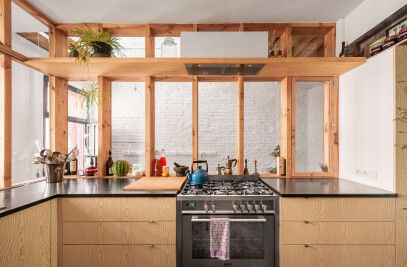The children had left home for a number of years, and retirement was just around the corner, so Paul and Monique thought: “Let's build a new house, tailored to our new way of life, so that we can face the future without any worries (and renovation or patchwork)...”


The design was fully geared to the quality of aging, the environment, the habits and activities of the residents, etc. All functions are located on the ground floor in a compact and logical plan, upstairs are two guest rooms with bathroom for the children and grandchildren.
At first sight, this house may seem strange in this context, but it actually integrates perfectly here and - despite the banality of an allotment - a lot of new quality and experience is added.


Paul has always been an independent contractor. He wanted to make one last effort before retiring by building his own house, and then enjoy it to the fullest.
The individuality of the residents and the context were mixed into a unique end result and Paul's skills were used to commemorate lifelong living in an allotment.


Instead of designing a house with a front garden, side gardens and back garden (with an obligatory garden house, hedges or fences), it was decided to build the house and Paul's workstead/garden house in stone. These two buildings were connected by a concrete structure. This creates an intimate garden between the two buildings, and the concrete structure provides a lot of peace and privacy with respect to the neighbors. The view is limited, and from the house the 'junk' that belongs to a garden is placed outside this structure so that it is not visible from the central garden. Elements such as carport, conservatory, beehives, vegetable garden, etc. are given their place outside the structure, so that living is focused on the peaceful atmosphere of the garden. This offers a lot of peace and quiet, and emotionally you are no longer in an allotment but in a world in itself.


The carport and conservatory were designed as one unit. These look spontaneous and feel familiar. Under this light structure you are covered at the front door, which is centrally located in the side wall. Through the entrance you enter the high living space that connects to the indoor outdoor space / patio and the garden. You walk along the patio to the kitchen, which is located on the street side. Monique is often busy in her kitchen, which is how she has visual contact with passers-by (often acquaintances from the village). The living space, on the other hand, is very private. Both kitchen and living room can be opened to the patio, giving the house a wonderful extra space during warm days.


In addition to the living room, there is a comfortable bathroom and the master bedroom also overlooks the garden. In the entrance there is a staircase to the guest rooms.
The house has several 'spots' where you can go as a resident, because sitting with two persons in one room all day long is rarely a good idea :)


The brick and concrete structure are visible from everywhere. The floor is a natural stone flagstone that continues to the outside. Inside and outside are linked in different ways. The warm wooden joinery and the wooden ceiling in the living room offer balance to the harder stone materials.
The sunlight is subtly drawn in in various ways throughout the day. The house is very clear and the patio provides a lot of daylight.
The pleasant interaction with the client led to a tailor-made suit that uniquely fits into the environment, within walking distance of the village centre.


Team:
Architects: atelier vens vanbelle
Engineers: UTIL


Materials Used:
Facade cladding: brick/concrete
Flooring: flagstone
Doors & Windows: wood (afselia), handmade
Roofing: derbigum
Interior lighting: zangra
Interior furniture: handmade
























































